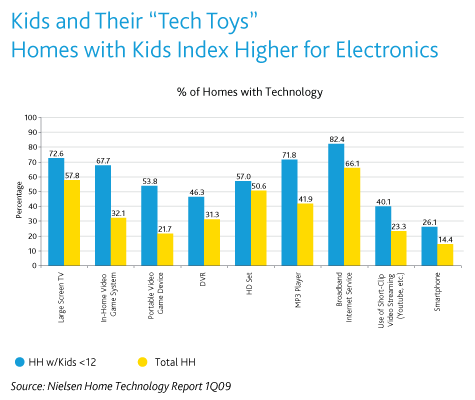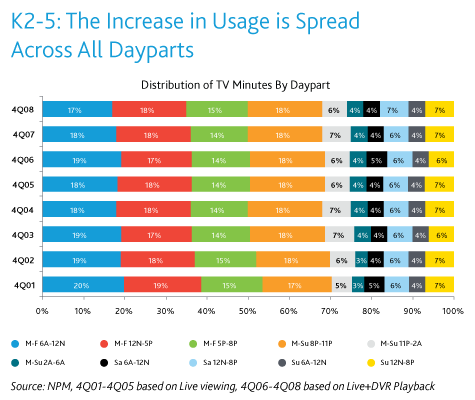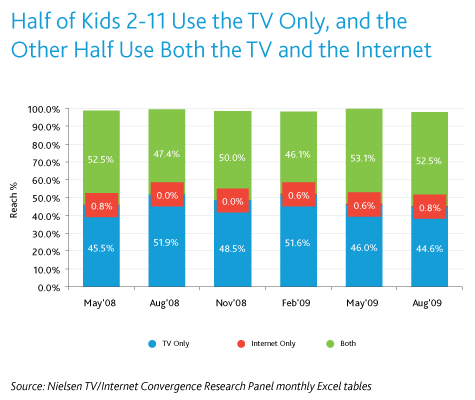
Patricia McDonough, Senior Vice President, Insights, Analysis and Policy
SUMMARY: Meet the mini media moguls who are dictating electronic sales and media utilization patterns in American homes: kids. TV still engages children of all ages, but older children gravitate toward the Internet, while younger kids embrace DVDs, VCRs and DVRs. Whether a solo use or co-viewing with friends and families, connected kids represent a fertile opportunity for advertisers.
If you’re trying to locate a child between the ages of 2 and 11, your best bet might be to start your search in the media room, where older kids (age 6–11) clock in more than 28 viewing hours per week, primarily watching TV, but also spending close to 2.5 hours watching DVDs or playing video games, with an additional hour dedicated to the DVR and 18 minutes set aside for the VCR.
Younger children age 2–5 log close to 25 hours of TV time each week, more than 4.5 hours watching their favorite DVDs, about 1.5 hours viewing DVR offerings, more than an hour competing at video games and 45 minutes with the VCR.
Viewing patterns prove predictable, with TV viewing among younger children peaking in prime time, and peripherals (DVD, DVR, VCR, video game console) use topping off just before prime time (7p.m.). Among older children ages 6–11, viewing and peripherals utilization spikes during prime time, with the exception of video games—an after school time slot favorite.
Tech toys
Little hands are busy hands, whether at the controls of a game console, an MP3 player, high definition TV set or smartphone. Electronic-intensive households tend to be those with kids under age 12 who actively lobby parents for the newest device. For example, 68% of households with children boast an in-home video game system vs. 32% of homes overall.

Thirty-two percent more households with young children report owning a portable video game device. Almost 30% more child-centric homes listed an MP3 player among their electronics; 17% more logged on to view short-clip video streaming. Sixteen percent more households with young children connected to a broadband Internet service. Roughly 15% more kid-focused homes boasted a digital video recorder and large screen TV. Kid-inclusive households seem to be more tech savvy, dialing up 12% more smartphones than the average domicile.
TV time
Despite the onslaught of new viewing devices and media, television remains a perennial favorite among all children ages 2–11, with TV use at an eight-year high when including DVR playback or time shifted viewing. Additionally, the distribution of TV minutes by daypart is distributed remarkably consistently throughout the viewing week for both younger and older children, with younger children tending to watch more weekday morning television.

When younger kids ages 2–5 handle the remote, their network choices vary by daypart, with PBS jump-starting the mornings, and kid-oriented cable networks accounting for two-thirds of the viewing options. Older youths ages 6–11 spent less time with PBS programming and almost three-quarters of their viewing day was devoted to kids cable network shows.
Program picks
Left to their own devices, children 2–5 and 6–11 primarily watch kids programming. When another person enters the room, the viewing equation changes. Only 9% of kids 2–5 watch broadcast network programming alone during the day, but that percent increases to 40% when another child 2–11 watches with them and rises even further to 82% when an adult 18+ co-watches. The same pattern holds true for older children 6–11: 24% watch a broadcast network during the day alone, 38% watch when another child is in the room and 63% co-view with an adult 18+.
Digital decisions
The transition to digital television has had little to no impact on children’s viewing habits for either youth age group, nor has it materially changed the medium’s overall reach. Kids still view the same percentage of TV in different rooms in the house. Younger children 2–5 are bidding VCRs adieu, making room in the media cabinet for DVRs, but DVDs still dominate playback options. Conversely, older kids 6–11 are less enamored with VCRs and DVD players.
Even with the advent of time-shifting viewing alternatives, younger and older kids both prefer live entertainment, with more than 97% of TV viewing done live versus same day or other playback alternative. When younger kids did select playback programming, they watched more commercials (50%) than any other age group. Older kids age 6–11 took in the same number of commercials as adults (44%).
Repeat, replay
Video on demand (VOD) viewing patterns reveal an interesting fact about kids. When they like a show, they really like a show and will watch it over and over and over again. Kids programming accounts for some 28% of total free video on demand content, with many of the top shows paralleling TV offerings like Nick Jr., Nickelodeon, PBS Sprout and the Cartoon Network.
The highest ranked kids shows on VOD enjoy almost twice the average repeat viewing numbers compared with other free VOD content. Episodes of the most popular shows like SpongeBob Square Pants™ , iCarly™, Dora the Explorer™ or The Backyardigans™ can reel in as many as 50 million total minutes viewed in a given month.
Web kinds
Internet utilization increases with age, with almost half of children age 6–11 surfing the Web compared to just one-fifth of younger kids age 2–5. The heaviest keyboarding time concentrates on the weekends and in the after-school and after-dinner time slots. For all children ages 2–11, results are evenly split, with nearly half utilizing TV only and a little more than half allocating time to both TV and the Internet.

More so than other age groups, almost 45% of children watched TV solely, without simultaneously accessing the Internet. Approximately 60% or more of teenagers and older adults were concurrent TV/Internet media users.
Live TV has dominated the share of video minutes for the last four quarters running for kids age 2–11, with online streaming increasing marginally for younger kids 2–5 and remaining flat for older youths 6–11. Accessible and adaptable, kids are quick on the uptake, willing to try new media and devices, but loyal to live TV. Diverse media consumers, their appetite for programming grows unabated, as does total viewing time, affording more touch points and time slots for flexible marketers.



